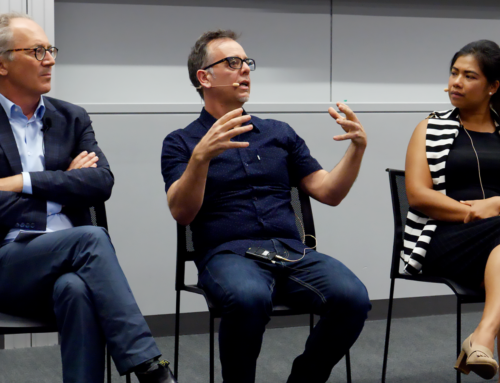Susannah Lai
The last panel of this year’s symposium turned to the wider implications of the ‘quantum race’ once more, providing a space for attendees to discuss and reflect on the information presented by other speakers. The panel was chaired by Professor James Der Derian, and the speakers were Mr Stephen Del Rosso, Professor Nisha Shah and Professor Ole Waever. Together they represented a panel from diverse industries and backgrounds, all with a particular interest in international relations and political science.
Professor Der Derian opened the panel, expounding on the aims of the Q Symposium. Everyone involved, he said, is eagerly looking forward to what will come from quantum and thinking hard about what needs to be done both to achieve the great potential of quantum technology, while also keeping it safe for the world. The panel followed this train of thought, mostly discussing the reasons behind quantum research, the interest and ‘hype’ surrounding it, and its potential for both great good and great ill. Although the topics did concentrate on speculation of what quantum technology will mean for the rest of society, along with dire warnings of what could go wrong, there was also optimism about what quantum might contribute and how it will be possible to change the currently concerning course that it is following.
The first speaker for this panel was Mr Stephen Del Rosso, representing the Carnegie Corporation, where he is the Program Director for projects in International Peace and Security. Quantum, he remarked, is a very difficult topic to discuss. This is not least because it is host to a great number of concepts that run contrary to the expectations of most people, such as how causality works, how AI and ‘cyber’ work (or rather, do not work in quantum), and the heavy media focus on the computing aspect of quantum.
Certainly, quantum is difficult to discuss due to the subversion of ‘normal’ Newtonian, somewhat intuitive, rules about cause and effect, which are often ambiguous at the quantum level. The world is, Mr Del Rosso declared, still in the ‘journey’ phase of quantum, and experts in the field are still working to comprehend how it works, never mind passing that understanding to laypeople.
On that note, he went on to muse about the comparison of the ‘quantum race’ to other technological races and the flaws in that method of thinking. In those races, he explained, there were tangible goals that are just not present in the ‘quantum race’. This means that any ‘quantum race’ is difficult to understand and quantify, and therefore difficult for policy makers and other interested parties to comprehend and respond accordingly. Moreover, the ‘space race’ and ‘atomic race’ were relatively short, frenetic periods of technological development, heavily underlined by national security concerns and hostile international politics. By contrast, the ‘quantum race’ is estimated to be a long-haul race, with the technological development occurring at a relatively slow pace. Additionally, while there are many national security concerns, the level of alarm and urgency is nothing compared to the atomic race, for example.
There are, Mr Del Rosso stated, a great many benefits the quantum could provide; not just dangers. Furthermore, he said, these would not necessarily be merely technological or scientific, but could be things like providing insight into social mechanics or similar areas. Would quantum, he mused, provide a perspective that would make a useful heuristic or metaphor? He briefly explored the metaphysical potential of a ‘quantum perspective’ and subsequently pondered how the description of quantum effects in physics seem to have potential application in describing social phenomena. Furthermore, he expounded on the topic of applying this perspective to a concept about the ‘delocalization of the I’.
Turning the topic to the political issues surrounding quantum technological research however, Mr Del Rosso’s tone became sombre, wondering about how long the international collaboration in the area could last, despite the healthy community around it presently. Since quantum research is still in its early stages, there is a lot more flexibility around the sharing of research in order to work towards mutual goals. However, as the field advances and the applications of the research become clearer, it is almost inevitable that this will change. Indeed, there are already researchers in the area of quantum key distribution ‘going dark’ from shared research forums between physicists. Presumably, if other technology eventuates from quantum research, and proves to afford an advantage to national interests, the same process will occur.
Mr Del Rosso then spoke on a topic nearer and dearer to him; that of research funding. Firstly, he commented on the sheer volume of investment into quantum research that is happening in China. After a certain point, he explained, it will not matter what the quality of the individual projects being sponsored are, since the sheer mass of investment will produce results regardless. Closer to home, he gave his own perspective on how to determine what projects are promising and in need of funding.
Professor Nisha Shah from the University of Ottowa spoke next, focusing on what people are trying to achieve through quantum research, what political environment would make it the safest, what future quantum could promise and how the use of language around quantum impacts that future and those politics. Fundamentally, she opined, this effort is the result of trying to understand the world as it is, even to the point that this quest for knowledge could enthusiastically fall headlong into self-destruction. This, however, does not mean that the quest for knowledge should be abandoned, Professor Shah said, but that solutions for staving off or neutralizing this potential should be investigated and implemented.
Part of this, she explained, is trying to understand the overall state of how quantum works and what it means. As Professor Shah put it, how do poets and social scientists, among others, relate to quantum, versus physicists and other technical professions? What, she asked, has been communicated between different professions in relation to quantum? Since it is such a technical topic, there are obvious difficulties in comprehending its complexities. After all, researchers in the field typically have long academic histories in the area, with much of the technical understanding coming from a solid base of years of learning in specialized subjects. The other question she raised was exactly how said poets and other non-technical professionals can help or contribute to the work of the physicists. On that point, particularly with relation to poets or other creative artists, the answer is most likely their ability to communicate complex concepts that need to be understood at a broad conceptual level.
Taking visual language as an example, symbols of computer code and ‘cyber’ created and used in popular media (for example, the green falling letters in the Matrix) and other similar symbols, have helped immensely to communicate high-level concepts in those fields to laypeople. With quantum severely lacking any true equivalent conceptual shortcuts, it is much more difficult to communicate at the high-conceptual level that allows laypeople to quickly understand what the purpose of a discussion or specific area of research is.
Underlining this point, Professor Shah moved on to talk about what a ‘quantum future’ would look like, and perhaps more pertinently, what ‘quantum weapons’ would look like. As most of the thought about quantum is currently defined by the technology around quantum computing and networking, she focused on the potential digital, or ‘cyber’ threat posed. ‘Unplugging’ the infrastructure would, she asserted, be just as damaging as dropping a bomb. This sort of thinking is reflected in the now famous, or infamous, ‘Digital Pearl Harbour’ analogy, and while its alarmist nature is often condemned, it is a relevant concern. Even the possibility for this potential to be realized is a risk. The idea that quantum technology would somehow enable, perhaps by undermining encryption or by overpowering victim computer systems, a cyberattack to do so much damage to digital infrastructure that it would be rendered inoperable or unable to be trusted in the accuracy of its transactions, is dangerous, without the need for any actual such event to happen.
That is because this possibility, likely or not, represents an existential threat that forcibly changes the dialogue surrounding the development of quantum technology. In a sense, it could be compared to a self-fulfilling prophecy: because the technology is framed in the language of fear and threats, or as a weapon to be wielded and defended against, it will develop along those lines. Therefore, Professor Shah warned, the fundamental language and assumptions of the potential uses of the technology needs to be challenged, lest the future of said technology is determined by the decision that it will develop a certain way. This could happen in a variety of ways, she explained; for example, perhaps there is a choice of developing a technology one way or another, and the more peaceful option is disregarded in favour of the more warlike option, probably by funding choices, with that peaceful line of development not even being considered because the warlike option is felt necessary to retain the balance of power. In this frame of mind, the assumption is that the choice is already made; it has to be, to ensure that hostile powers will not have a material advantage, and thus the choice is not a choice.
This mentality, of course, leads straight into the pessimistic doomsday scenarios that were presented over the course of the symposium. Still, Professor Shah opined, these scenarios are completely avoidable at the current state of development in quantum technology. If the language surrounding quantum technology is changed, it is still eminently possible to redirect development and make it more likely that quantum will not be employed to cause violence, whether that be State to State, or used against the general population to control and erode individual human rights (particularly privacy). For this, she declared, it is not metaphors relating to how development might proceed that are needed, but a manifesto declaring how it should. As the world moves into a new technological infrastructure, it is necessary to think about how these change power structures, and furthermore, carefully consider what new forces might emerge to affect those power structures.
In a continuation of this theme, Professor Ole Waever, of the University of Copenhagen’s International Relations department and coiner of the term ‘securitization’, concluded the panel. He focused particularly on the effect of language and modes of thinking around quantum technology, and technological development in general, as well as the potential consequences of this development on society. Care needs to be taken, he explained, when assessing the positives and negatives of a situation, and depending on influencing factors, positives can turn into negatives and the negatives can take over. In particular, ‘securitization’ has a habit of effecting this change, as by nature, thought is focused on threats and what measures need to be taken with regard to those threats. Professor Waever brought up the example of the development of nuclear technology. In its very early stages, it was focused on the potential of nuclear power as opposed to fossil fuels, with the possible creation of weapons as a side issue, but by the end of the century the focus had entirely changed to nuclear weapons.
Professor Waever then echoed the sentiments of Professor Shah, speaking on the need to consider the effect of politics on the development of technology, as political beliefs and concerns determine what kind of technologies are created. Social dynamics are often materialized in the development of technology, he explained, so it is vitally important to both acknowledge this and to be careful and aware of what boundaries are being created. The effect that politics and language has on the development of technology is reciprocal; technological developments will impact and change politics and language by offering new possibilities and creating new forces in the socio-political environment. But the language and politics of expectations around the development of a technology with affect how even the technical researchers think about the possibilities of that technology, inclining them one way or another when thinking about applications of results. It has an even greater effect on policymakers who are trying to govern the development of said technology, and naturally, the investors, who will pick projects that appeal to their idea of how the technology could or should develop. Warlike expectations will necessarily push development along those lines, because everyone involved will look at effects and phenomena produced and try to figure out applications for weapons.
As such, Professor Waever declared, the fundamental conception of ‘quantum’ as a race is inherently harmful and extremely dangerous. Terming it a ‘race’ means that language and perceptions of the technology views its development to be competitive, having clear winners and losers, ‘prizes’ to be won, with the losers being at a disadvantage. Worse, considering the more famous, or infamous, technological races in recent history, it would be very easy to perceive the ‘quantum race’ as not merely a race, but as a ‘arms race’. Thinking about it in that fashion would change the perception of the technology, making it about designing, building and stockpiling weapons. Even a mere ‘technological race’ has dangers; it can lead to the precipitous release of new technology in attempts to reach perceived milestones in the race first, leading to carelessness and a distinct lack of foresight about the potential consequences, safety and effects of said technology.
The clearest evidence of this is in a technological race that was not state-sponsored, but rather occurred between various large tech companies competing to release mass communication platforms and social networking apps. This resulted in the advent of social media, which has certainly revolutionized and democratized information distribution to an even greater degree than the internet itself. However, recent events have shown this to be a dangerous tool indeed; not merely for opening the possibility of ‘information operations’ on scales and in forms previously unimaginable, but also in the ability to create ‘echo chambers’ that support radicalization to an unprecedented degree. Efforts are being made to curb negative impacts, but the metaphorical genie was let out of the bottle some years ago.
Leaving aside the destructive potentials of technological ‘races’, Professor Waever stressed that the continued framing of quantum as a race makes it increasingly likely for that ‘race’ to be an ‘arms race’. This mode of thinking, securitization, is easier to fall into when technological development is considered to be a race. This is in part due to the feeling of competitiveness that it engenders, and the seeking of power to either disrupt or maintain the perceived ‘balance of power’ and status-quo.
It is vital, Professor Waever concluded, to be very careful about how power structures are incorporated into technology as it develops and how the development of technology is discussed when it could have an effect on that power structure. If caution is not taken as events proceed, all the dire predictions expressed in this symposium have a corresponding increase in likelihood of coming true. Securitization is a powerful force, he said, and a seductive way of thinking.
In some ways, making an issue about security simplifies how it needs to be handled; it is about national security and therefore it must be about conflict, offence and defence. The morality, and moral quandaries of developments coming out of that technology are set aside in favour of working purely on the weaponization potential of said developments. On the other hand, even with a relatively ‘peaceful’ route of development, it is possible that technological developments could become amplifiers of current power structures; to the disadvantage of the general population. Social media is an odd example of this; it is both disruptive, destroying some power structures, even as it reinforces others.
While social media broke the stranglehold of traditional media, and equalized the ability to influence public discourse, it also boosted inequality in other areas, allowing social media companies to aggregate and monetize the personal information of their users to a unique degree. That social media also boosted authoritarianism is another issue worthy of examination. The development of this technology was very much rushed into, with multiple platforms competing bitterly in the early stages to capture user bases, as lacking a substantial user base signified the inevitable failure of the platform. Quantum, too, could fall into this trap, as the first ‘quantum computer’ would have an advantage in the development of software, which would lead to people choosing to use that platform and subsequently normalizing it. If alternative systems are not compatible, it will be hard to break into the market, leading again, to the inevitable failure of alternative platforms.
All these considerations underline the point that Professor Waever made: if development is rushed and new technologies churned out without due consideration, harm being done is more likely than beneficial or even neutral results. More chillingly, that harm could come from directions that are ‘out of left field’ and proceed to leave lasting scars that are difficult to erase. Nevertheless, this does not need to be the result of quantum; there is still time to put the policies in place that will ensure that the possibility of ‘securitization’ is blunted, and that any developments are carefully examined before their release into the wilds of society.







Leave a Reply